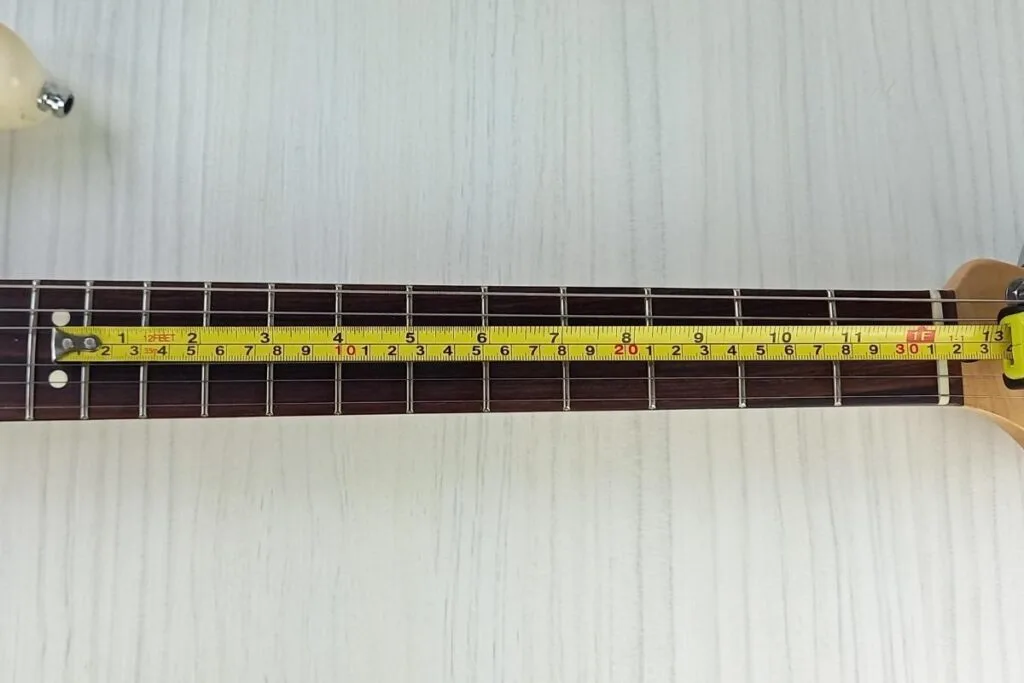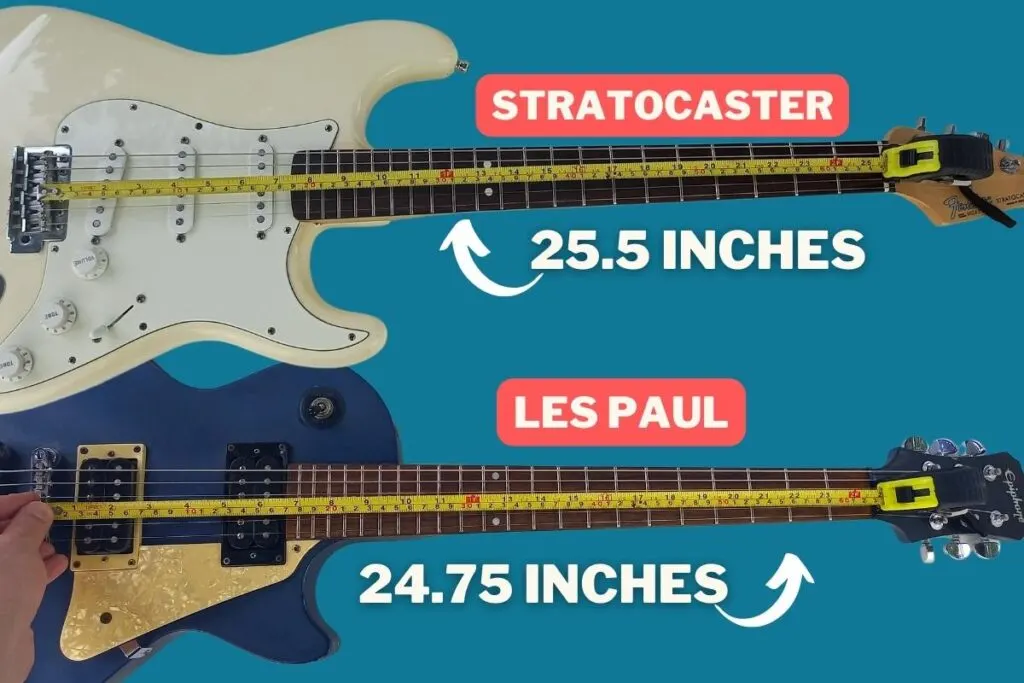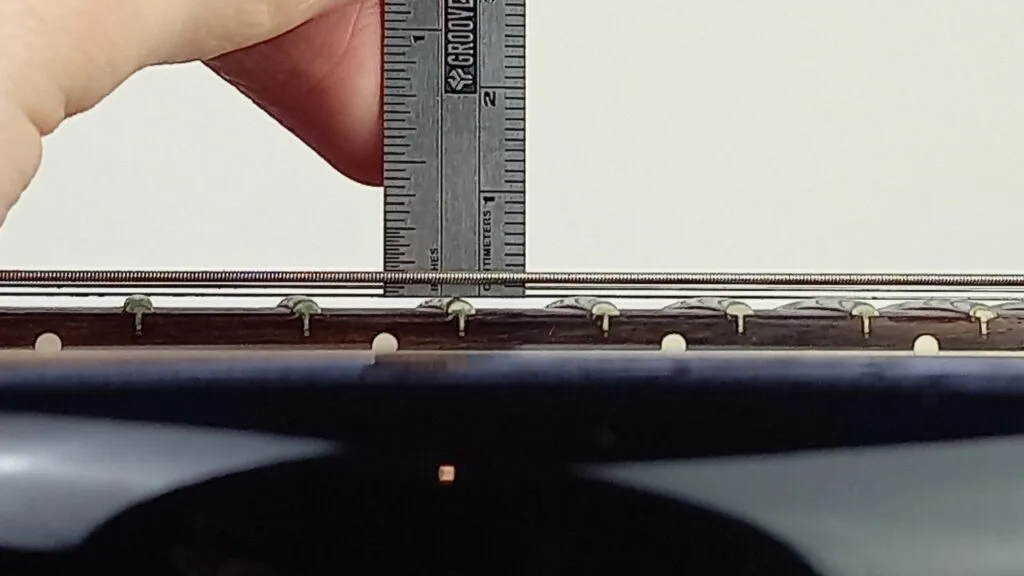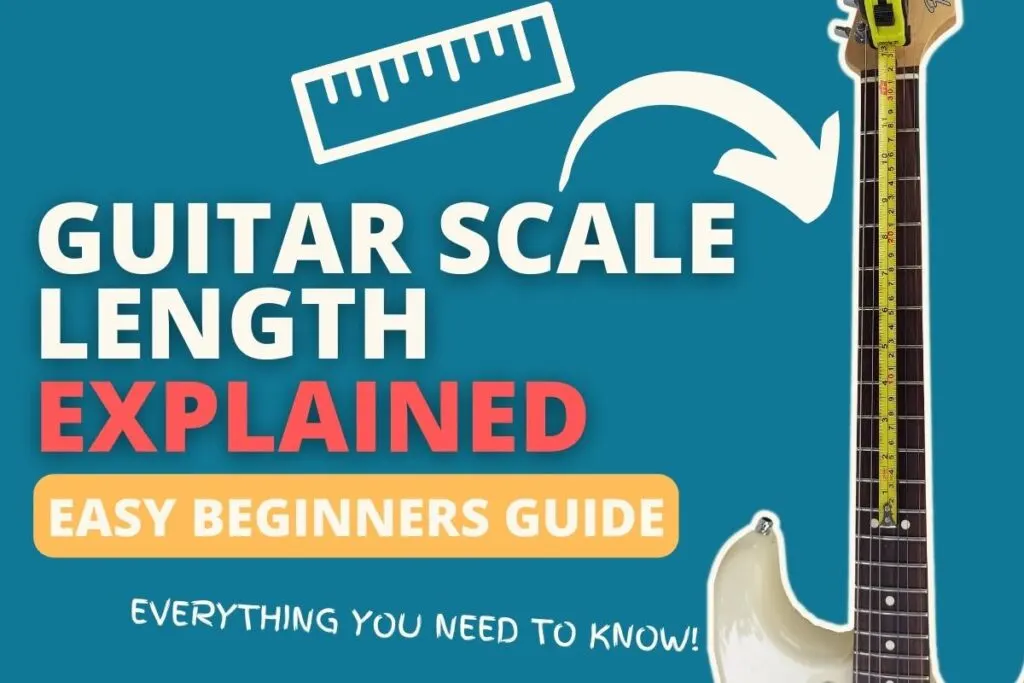Scale length is an often overlooked factor by guitar players, but has a large impact on how a guitar sounds and feels to play.
It’s the reason that bass guitars are so much larger than regular guitars, and is one of the factors that makes different models of guitar feel so different to play. It’s also one of the reasons that tuning-down a guitar to a lower tuning can make the strings floppy and unplayable.
Let’s take a look at guitar scale length to fully understand how it affects your guitar, and how you can work with it to get the best sound out of your gear.
What is “guitar scale length”?
The scale length on a guitar is the distance measured between a guitar’s nut and bridge, usually given in inches. It has a large effect on how a guitar feels to play, its string tension, and how it handles certain tunings. Most 6 string electric guitars have a scale length between 24 and 25.5 inches.
How to measure a guitar’s scale length
The most accurate way to measure a guitar scale length is to measure the distance between the nut and the middle of the 12th fret. Then, double this measurement for the scale length.

But, why not just measure the full distance between the nut and bridge? Your guitar bridge has saddles that can be adjusted very slightly to improve the intonation of the guitar, meaning how “in-tune” it is across the fretboard. These slight differences in the saddles can throw off the measurements. So, it’s more accurate to measure scale length at the 12th fret, as it never moves.
If you’re unable to measure your guitar scale length, you can just check out the manufacturer’s website. They should have all the details about your guitar model.
How does scale length affect a guitar?
Scale length affects two main things on a guitar: the string tension, fret spacing, and tone (to a degree). The string tension goes on to affect the height of the guitar strings (or “action”) and their tuning.
String tension
String tension means how tight the strings are on a guitar. A higher string tension means tighter strings, whereas a lower string tension means that the strings are more relaxed. Scale length plays a key role in how high or low string tension is on a guitar.
The best way to show this is to compare two guitars with different scale lengths that use the same type of guitar strings. The strings on the guitar with the shorter scale length would feel a bit “looser”, meaning that techniques like string bends and vibrato will be a bit easier.
I’ve noticed this on my Les Paul and Stratocaster. Both are fitted with the same type of strings, but the Les Paul has a 24.75″ scale length and the Stratocaster has a 25.5″ scale length. The Les Paul has a lot less resistance to string bends, which feels easier to play.

That being said, string tension goes hand-in-hand with string gauge.
The string gauge is the thickness of the guitar string. Generally speaking, a thinner string (or a “lower string gauge”) has less string tension than a thicker string.
So, what does this mean for scale length? If you find that the higher string tension from the scale length is too hard to play, then you can change your guitar strings to a lower gauge. This will make the strings easier to play.
So, let’s use my Les Paul and Stratocaster as an example. If the strings on my Stratocaster are too hard for me to bend, I can switch them to a lower gauge. This will lower the string tension, making them more flexibility and easier to bend.
But, if the tension is too low, then they will flop around and rattle – causing fret buzz and intonation issues.
String height (or “action”)
Your guitar’s string height (also called “action”) is the distance between the bottom of your guitar string and the top of your frets. A lower string height means that there’s less of a gap between the string and the frets. Most people prefer to have a lower string height as it’s generally more comfortable to play.

So, what does this have to do with scale length? Well, string height goes hand-in-hand with string tension. If the string tension is too low, and the string height is too low, then the strings are going to rattle against the frets. This causes fret buzz. In this case, you’ll need to raise the string height to compensate for the lower tension.
As you can see, there’s a very close relationship between scale length, string tension, and string gauge – all of which affect the playability of your guitar.
String tuning
Have you ever tried to tune your guitar down to a lower tuning? If you have, you’d have noticed that the strings become a lot looser to play. If you tune down too far – they become so loose that they’re unplayable. This is influenced, in part, by the guitar’s scale length and string tension.
As a longer scale length means a higher string tension; guitars with longer scale lengths are often used for lower tuning (called “drop tuning”). This is best demonstrated with “baritone” guitars. These are special guitars with a longer scale length (usually over 27 inches) that are used to play lower notes than a standard guitar.
Guitars with longer scale lengths are often used for hard rock and metal to achieve lower tunings. That being said, using a higher string gauge on a guitar with a shorter scale length will achieve a similar effect due to the string tension.
Fret spacing
Scale length also affects playability in another way: the length of the distance between the guitar frets. A guitar with a higher scale length will have a larger distance between frets.
Now, this won’t make too much of a difference. In fact, if you’re not paying attention, you might not even notice the difference between the two. But, if you were to compare a standard electric guitar with a baritone guitar, or even a bass guitar, you’ll definitely notice the difference.
Personally, I don’t notice the fret spacing difference between my guitars that much, but it is noticeable if I pay attention. To me, the guitar neck thickness and fretboard radius make more of a difference to playability. That being said, if you’re a guitarist with smaller hands, you may prefer a guitar with a shorter scale length as the frets are closer together.
Guitar tone
Finally, a guitar’s scale length will play a part in its overall tone. This is because it changes the length of the string, and how the string vibrates. A guitar with a larger scale length has longer strings compared to a guitar with a smaller scale length.
The longer a guitar string is, the further the strings harmonics are spread out, which results in a “brighter” sound with more high-end frequencies. Likewise, a shorter string length will mean that the harmonics closer together, which sounds deeper and warmer.
This can be seen clearly in the Les Paul and Stratocaster comparison. The Stratocaster is known for its bright, twangy tone, and the Les Paul for its warm, mellow sound.
That being said, scale length is only one factor that affects tone – and a minor one at that. Things like a guitar’s construction, pickups, and the amp you use will have a much larger impact on the guitar’s overall tone.
Still, it’s an interesting observation that may matter to some players. Here’s a great video that demonstrates further how scale length affects tone.
Short scale guitars
Some guitar manufacturers offer “short scale” guitar models, often aimed at beginners or smaller players. You’ve probably seen them called “3/4 sized” guitars or something similar. These guitars are essentially shrunk down versions that have a smaller scale length.
Some popular models include the Fender Squier “Mini” series, the Jackson “Dinky” series, and even Fender’s mainline Jaguar and Mustang.
The benefit of these guitars is that the frets are much closer together, which is great for players with smaller hands. The shorter scale length also means that the strings will be more responsive to bending, which can be easier on small hands.
But, short scale guitars aren’t just for beginners. Professional players like Kurt Cobain are famed for their use of short scale guitars like the Mustang and Jaguar.
Guitar scale length chart
Knowing the scale length of a guitar can be a good indicator of how comfortable it could be to play, and the tuning you might use.
Here’s the common scale length for the full sized models of the different types of guitars. There’ll always be some outside of this range, but these are the most common.
| Guitar type | Scale Length ( ” / inches) |
|---|---|
| Electric Guitar (6 strings) | 24 – 25.5 |
| Acoustic guitar | 24.75 – 25.5 |
| Electric guitar (7 strings) | 25.5 – 27 |
| Classical guitar | 25.6 – 26 |
| Baritone guitar | 27 – 30.5 |
| Bass guitar | 34 – 36 |
And, here’s a list of the guitar scale lengths for some popular models of electric guitar.
| Guitar model | Scale length ( ” / inches) |
|---|---|
| Fender Jaguar | 24 |
| Fender Mustang | 24 |
| Gretsch G5220 | 24.6 |
| Epiphone Les Paul | 24.75 |
| Gibson ES-335 | 24.75 |
| Gibson Explorer | 24.75 |
| Gibson Flying V | 24.75 |
| Gibson Les Paul | 24.75 |
| Gibson SG | 24.75 |
| Gretsch G2622 | 24.75 |
| PRS SE Custom 24 | 25 |
| PRS SE Hollowbody Standard | 25 |
| Fender Squier Stratocaster | 25.5 |
| Fender Squier Telecaster | 25.5 |
| Fender Stratocaster | 25.5 |
| Fender Telecaster | 25.5 |
| Ibanez RG550 | 25.5 |
| Ibanez RG565 | 25.5 |
| Yamaha Pacifica 112V | 25.5 |
Conclusion
Guitar scale length is an important and often overlooked factor that has a lot to do with how a guitar feels and plays. Guitars with a longer scale length have a higher string tension compared to one with a shorter scale length (using the same type guitar strings).
Knowing the scale length of a guitar, and how it affects your string height, tuning, and tension can really help you get the best sound out of it.
Guitars with a shorter scale length have the frets closer together, which can be easier to play for beginners and guitarists with smaller hands.
Ultimately, guitar scale length is only one of the pieces of the puzzle when it comes to guitar playing comfort. Other factors like fretboard radius and guitar neck thickness will play an equally important role.
Related questions


Conor is a music producer, multi-instrumentalist, and all-round enthusiast from the UK with over 15 years of experience. He’s the founder and sole-content creator for the roundtable audio blog and YouTube channel.
